The History:
At the beginning of December in 1941 the United States was not involved in the war that was being waged in Europe and Asia. Public opinion favored isolationism, people felt that the United States should not get involved in conflicts between other countries. On December 7, 1941 the Navy of Imperial Japan conducted a pre-emptive strike against Hawaii's Pearl Harbor. 2,402 servicemen and servicewomen were killed, another 1282 were wounded, and almost two hundred American ships and aircraft were lost.
Citizens of the United States were stunned, outraged, and frightened. There had been interracial problems before the attack on Pearl Harbor. After the attack, public sentiment against people of Japanese ancestry increased exponentially and sometimes there were outbreaks of violence.
In California over 2/3 of the people who were identified as Japanese were actually citizens of the United States. They had been born here, they were raised here, they attended school here, they developed businesses here, they voted here, they were Americans. Japanese-Americans struggled to remind their countrymen of that fact.
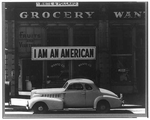
San Francisco, Calif., Mar. 1942. A large sign reading "I am an American" placed in the window of a store, at 13th and Franklin streets, on December 8, the day after Pearl Harbor. The store was closed following orders to persons of Japanese descent to evacuate from certain West Coast areas. The owner, a University of California graduate, was housed with hundreds of evacuees in War Relocation Authority centers for the duration of the war. / Photo attributed to Dorothea Lange.
There were rumors that people of Japanese heritage were signaling Japanese U-boats off the West Coast of the country. Japan's forces had been spectacularly successful in Asia. There was fear that Imperial Japan was preparing to mount a full scale attack on the United States.
President Franklin D. Roosevelt issued a series of Presidential Proclamations and Executive Orders focused on people of Japanese descent. The first of these tracked people, commanding that they report all changes in residence, employment, and name to the Federal Bureau of Investigation. Subsequent orders gave military commanders the authority to designate areas of the United States as "exclusion zones" and to have all people who were 1/16 or more Japanese removed from those areas and sent to incarceration camps for the duration of the war.
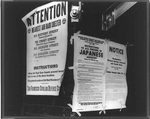
Civilian exclusion order #5, posted at First and Front streets, directing removal by April 7 of persons of Japanese ancestry, from the first San Francisco section to be affected by evacuation. / Photo attributed to Dorothea Lange.
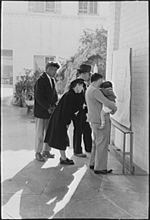
'Los Angeles, California. Japanese-American evacuation from West Coast areas under U.S. Army war emergency order. Reading evacuation orders on bulletin board at Mary Knoll mission. / Photograph by Russell Lee.
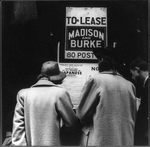
Shoppers reading US Army exclusion order No. 20 directing evacuation of persons of Japanese ancestry, San Francisco. / Photo attributed to Dorothea Lange.
Notices were posted commanding people of Japanese ancestry to report for transport to Civilian Assembly Centers. Most people in California were transported by train. At the train stations people were tagged, and then they boarded the train to be taken to the camps.
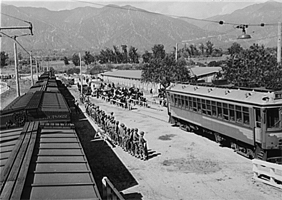
Los Angeles County, California. The evacuation of
Japanese and Japanese-Americans from West
coast areas under United States Army war emergency order. Japanese waiting for registration at the Santa Anita reception center. / Photograph by Russell Lee.
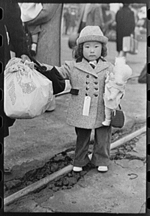
Los Angeles, California. Japanese-American evacuation from West Coast areas under U.S.
Army war emergency order. Japanese-American child who will go with his parents to Owens Valley. / Photograph by Russell Lee.
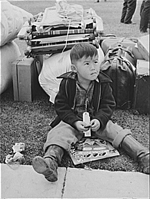
Salinas, California. Tagged for evacuation. / Photograph by Russell Lee.
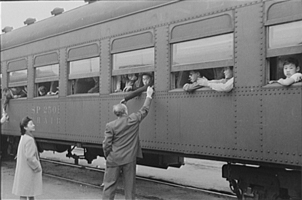
Los Angeles, California. The evacuation of Japanese-Americans from West Coast areas under U.S. Army war emergency order. Leaving for Owens Valley. / Photograph by Russell Lee.
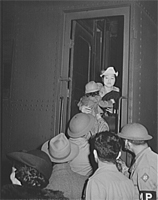
Los Angeles, California. The evacuation of Japanese-Americans from West coast areas under United States Army war emergency order. / Photograph by Russell Lee.
The trains took people to Assembly Centers.
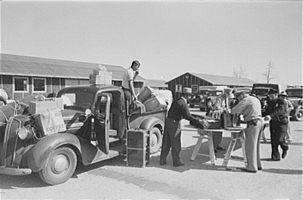
Santa Anita reception center, Los Angeles County, California. Baggage of Japanese-Americans being inspected as they arrive from West Coast areas under U.S. Army war emergency order. / Photograph by Russell Lee.
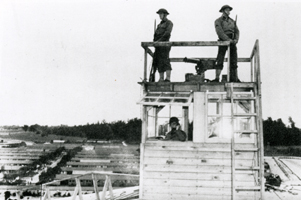
Watch-tower guards in the Santa Anita park assembly center for evacuees of Japanese ancestry. / Photograph by Clem Albers.
Eventually most of the people who had been incarcerated were sent to Relocation Camps.

Evacuees of Japanese descent at the
assembly center from which they will be
transferred ultimately to a War
Relocation Authority center for the
duration of the war, Salinas, Calif. / Photograph by Clem Albers.

Mr. and Mrs. Dennis Shimizu / Photograph by Ansel Adams.
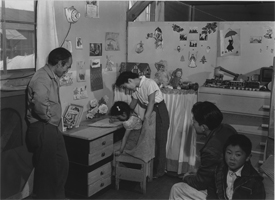
Toyo Miyatake, standing in his children's
bedroom looking at his young daughter
seated at a desk, drawing, while her mother
stands behind her at the Manzanar Relocation Center. / Photograph by Ansel Adams.
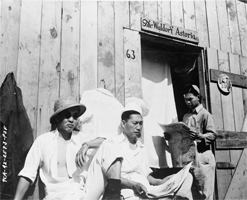
Photograph shows three incarcerated Japanese men sitting by a wooden building with the words "The Waldorf Astoria" written over the doorway.
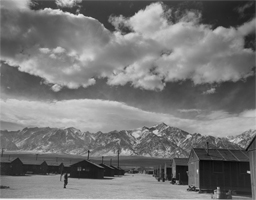
Manzanar street scene, clouds, Manzanar Relocation Center, California. / Photograph by Ansel Adams.
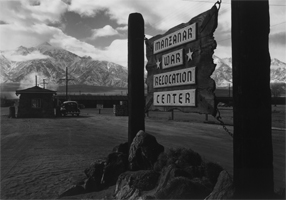
Wooden sign at entrance to the Manzanar War Relocation Center with a car at the gatehouse in the background. / Photograph by Ansel Adams.
The Collection:
The people incarcerated at the Assembly Centers and the Relocation Camps published their own newspapers. The library has an exhaustive set of these on microfilm, under the title Records of the War Relocation Authority, 1942-1946. One-third of the purchase was funded through a grant obtained by professor Cherstin Lyon, the other two-thirds was funded by Pfau Library.
Pfau Library has an extensive collection of the actual camp newspapers. These were purchased at the direction of the Library Director then, Art Nelson and they are held in Special Collections & University Archives. Browse cataloged items from this collection in OneSearch.
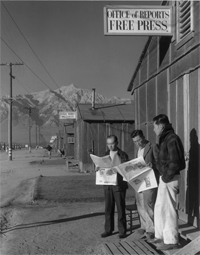
Roy Takeno, editor, and group reading paper in front of office, Manzanar Relocation Center, California / photograph by Ansel Adams
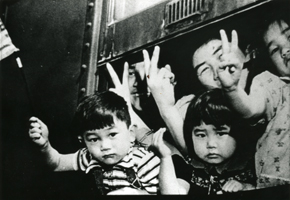
Bainbridge Island. Japanese American children waving from train windows (waving U.S. Flag and signaling "V" for Victory for America) on departure from Seattle for a detention camp. / Photograph by the Seattle Star.